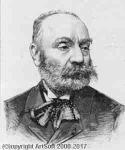Gustave Clarence Rodolphe Boulanger
Gustave Clarence Rodolphe Boulanger
Place: Paris
Born: 1824
Death: 1888
Biography:
Gustave Clarence Rodolphe Boulanger was a French figure painter known for his classical and Orientalist subjects.
Boulanger was born at Paris in 1824. He was orphaned at age 14, and his uncle and guardian subsequently sent him to the studio of Pierre-Jules Jollivet and then to Delaroche in 1840. In 1849 took the Prix de Rome with his painting, Ulysses, a work which combined a classical approach with Orientalist overtones.
In 1845, he first visited Algeria and this gave him an interest in Orientalist themes, which was taken up later by his friend Jean-Léon Gérome. Boulanger's knowledge of Pompeii, which he visited while studying at the École de Rome, also gave him ideas for many future pictures. His paintings are prime examples of academic art of the time, particularly history painting. Boulanger had visited Italy, Greece, and North Africa, and his paintings reflect his attention to culturally correct details and skill in rendering the female form. His works include a Moorish Cafe (1848), Cæsar at the Rubicon (1865), the Promenade in the Street of Tombs, Pompeii (1869), and The Slave Market (1888). The recipient of many medals, he became a member of the Institut de France in 1882.
He began teaching at the Institut de France in 1882 and was an influential teacher, noted for his dislike of the Impressionism.
Boulanger taught at Académie Julian, among his students were :
Ulysse et Euryclée, 1849
Hercules and Omphale, date unknown
Après le bain, 1867
C'est un Emir, 1870
The Slave Market, 1886
This article incorporates text from a publication now in the public domain: Gilman, D. C.; Peck, H. T.; Colby, F. M., eds. (1905). "article name needed". New International Encyclopedia (1st ed.). New York: Dodd, Mead.
More...
Wikipedia link: Click Here














